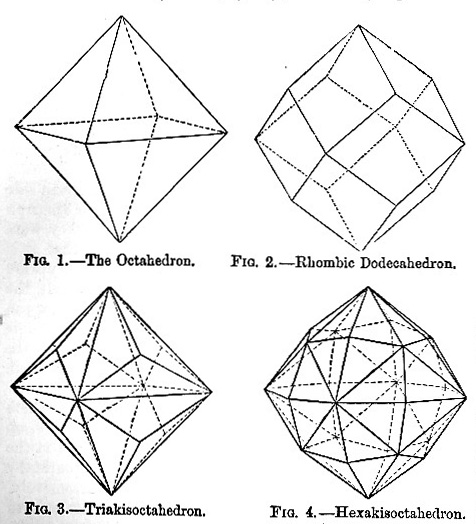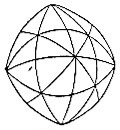1902 Encyclopedia > Diamond > Mineralogical and Physical Characteristics of Diamonds
Diamond
(Part 2)
Mineralogical and Physical Characteristics of Diamonds
The diamond always occurs in crystals of the tesseral or cubical system. Its most frequent forms are the octahedron, or double four-sided pyramid (fig. I), the rhombic dedecahedron with twelve faced (fig. 2), and other with twenty-four (fig. 3), and forty-eight faces (fig. 4).

Fig. 1 -- The Octahedron
Fig. 2 -- Rhombic Dodecahedron
Fig. 3 -- Triakisoctahedron
Fig. Hexakisoctahedron
The first form is most common in stones from India, the second in those from Brazil. Cubes also occur, but are rare, whilst the icositetrahedron has not been observed. Hitherto the diamond has own and G. Rose’s researches shows it to be holohedric (in the Berlin Monatsberichte, Oct. 1876). The faces are often curved, strongly striated, or maked by stair-like inequalities, hiding the true form. Many of the crystals also are round almost like spheres (fig. 5), or the smaller ones like grains of sand. This does not arise, however, from attrition during transport, by water, but is the original shape of the stone. Macles, or twin-crystals, specially of two octahedrons, are common, and the striae due to this structure appear even on the polished facets.

Fig. 5
The diamond has a perfect cleavage parallel to the faces of the octahedron, and breaks readily both in this and other directions. Contrary to the old and still common opinion, it is rather brittle, and is easily injured by a slight blow or fall. Its hardness – 10 in the mineralogical scale – far surpasses that of all other known stones, an was used even by the ancients to discriminate it from other gems.
In specific gravity, 3.52 (or 3.515 to 3.525), it is considerably higher than rock crystal, but nearly the same as the topaz, which may thus be mistaken for it. According to Fizeau, it has its greatest density at -42.3 ° C., and below this begins to expand, a property seen in very few other solid bodies.
Its expansion by heat is very small, the volume from the freezing to the boiling point of water only rising from 1.0 to 1.00000354. By friction it becomes positive electric. The so-called compact diamond or carbonado of the stone polishers, found as round grains or masses of one or two pounds weight in the washings near Babia, of a brownish black colour and sp. g. = 3.012 to 3.416, is porous diamond mixed with a small amount of other matter.
Read the rest of this article:
Diamond - Table of Contents
|

